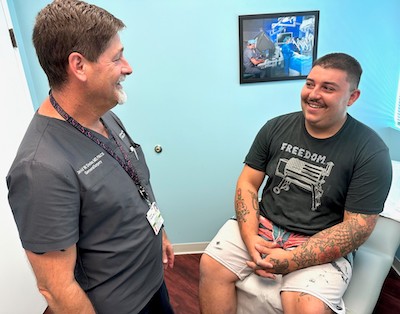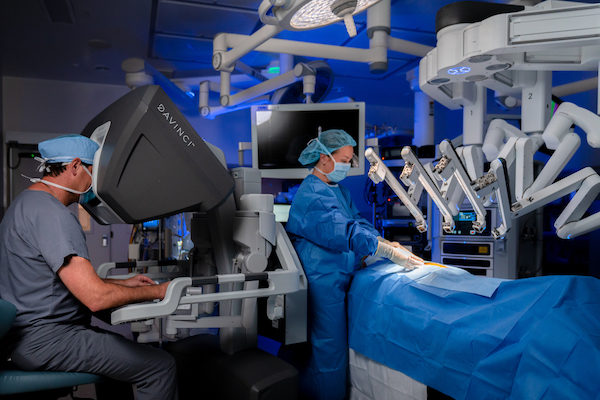Minimally Invasive Robotic Surgery
Surgeons at Lakewood Ranch Medical Center use the da Vinci Xi® surgical system. With this advanced robotic platform, procedures are performed using small tools attached to a robotic arm, which the surgeon controls with a computer. This may result in less pain, scarring, trauma and blood loss than other surgical procedures and patients can potentially return to work and daily activities sooner.*
Patient success stories
Michael Shatto – Gastrointestinal Cancer Surgery
Watch this video to learn how Michael Shatto went from stage four cancer to being cancer free after having robotic surgery at Lakewood Ranch Medical Center.
Taylor Butler – Robotic Splenectomy
 Taylor Butler was diagnosed with Idiopathic Thrombocytopenic Purpura (ITP), a rare autoimmune disease that occurs when the spleen destroys too many of the body’s platelets prematurely. He had his spleen removed through a minimally invasive robotic procedure. “In my case, robotic splenectomy was life-changing,” said Taylor.
Taylor Butler was diagnosed with Idiopathic Thrombocytopenic Purpura (ITP), a rare autoimmune disease that occurs when the spleen destroys too many of the body’s platelets prematurely. He had his spleen removed through a minimally invasive robotic procedure. “In my case, robotic splenectomy was life-changing,” said Taylor.
Are you a candidate for robotic surgery?
Your surgeon can help you decide if robotic surgery is the right option for you. To find a robotic surgeon, please call our free physician referral service at 800-816-4145 or search our online directory.
Robotic procedures
Surgeons at Lakewood Ranch Medical Center perform a variety of robotic procedures, including:
- General surgery
- Colorectal surgery
- Gynecologic procedures
- Weight loss surgery
- Urology surgery
Learn more about these robotic procedures →
Why robotic surgery?
Minimally invasive surgical techniques enable surgeons to operate through small incisions or existing body openings, rather than the large incisions that accompany traditional open surgery. When surgeons perform conventional minimally invasive procedures, their vision, range of motion and access to desired areas of the body can be limited. Robotic surgery can help alleviate these issues.
The da Vinci surgical system offers maximum precision, 3D rotation and 3D magnification that can enable surgeons to maneuver into the confined spaces of the body. The da Vinci system consists of a surgeon's console, a patient-side cart with four interactive robotic arms, a high-performance 3D, HD vision system and the system's EndoWrist® instruments. Using advanced robotic technology, the da Vinci system is designed to translate a surgeon's hand movements into precise movements of the EndoWrist instruments. This technology can provide a greater range of motion and precision to treat patients.
All robotic surgery procedures are minimally invasive, but not all minimally invasive procedures are performed robotically. Depending on your condition and the type of procedure you need, you may have options regarding the surgery technique. Talk to your physician to discuss what options are right for you.

Surgeon operating using the da Vinci surgical system
The da Vinci Xi Surgical System
The da Vinci Xi surgical system was designed with the goal of further advancing the technology used in minimally invasive surgery. It can be used across a spectrum of minimally invasive surgical procedures and has been optimized for multi-quadrant surgeries in the areas of gynecology; urology; and thoracic, cardiac and general surgery.
By enabling efficient access throughout the abdomen or chest, the da Vinci Xi surgical system expands upon core da Vinci features, including wristed instruments, 3D-HD visualization, intuitive motion and an ergonomic design. As with all da Vinci surgical systems, the surgeon is 100% in control of the robotic-assisted system, which translates his or her hand movements into smaller, more precise movements of tiny instruments inside the patient’s body. The immersive 3D-HD vision system provides surgeons a highly magnified view, virtually extending their eyes and hands into the patient.
Key features include:
- A new overhead instrument arm architecture designed to facilitate anatomical access from virtually any position
- A new endoscope digital architecture that creates a simpler, more compact design with improved vision definition and clarity
- An ability to attach the endoscope to any arm, providing flexibility for visualizing the surgical site
- Smaller, thinner arms with newly designed joints that offer a greater range of motion than ever before
- Longer instrument shafts designed to give surgeons greater operative reach
Benefits of Robotic Surgery
Robotic surgery may provide a number of benefits to patients, including:*
- Reduced pain and trauma to the body
- Less blood loss and reduced need for transfusions
- Less postoperative pain and discomfort
- Lower risk of infection
- Shorter hospital stays
- Quicker recovery and return to work
- Less scarring and improved cosmetics
- More precise surgery
*Individual results may vary. There are risks associated with any surgical procedure. Talk with your doctor about these risks to find out if robotic surgery and minimally invasive surgery are right for you.
